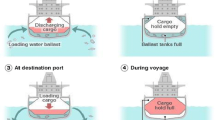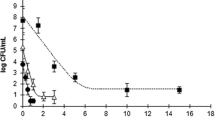Abstract
The current application of the zero discards policy in EU fisheries poses economic and logistic problems to fishing vessels, which are obliged to retain and preserve unwanted catches on board. The installation of compaction devices on board can effectively reduce the space requirements and the refrigeration loads to store these materials on board. In the current work, the performance of a pilot hydraulic press was optimized to attain a maximal volume reduction (i.e., maximal yield of press liquor) while keeping a reduced pollution load of the liquid effluents. To this end, a designed experiment was conducted where the yield (Y), the content of suspended solids (SS), and the chemical oxygen demand (COD) of the press liquor were related to the main operation parameters of the pilot plant (i.e., number of pressing steps and time of relaxation between consecutive steps). Statistical modeling, coupled to a multiobjective optimization technique (i.e., the weighted-sum method), was employed to find a set of optimal solutions meeting three objectives: maximal Y (i.e., maximal volume reduction of the press cake), and minimal SS and COD of the press waters. This approach concluded that 5 pressing steps and a time of relaxation between 105 and 120 s ensured a low content of SS (0.0170–0.0185 kg solids/kg sardine), while the yield was high (0.1942–0.2001 kg liquid/kg sardine) and COD remained below 24.4 g O2/kg sardine.




Similar content being viewed by others
References
Antelo LT, Lopes C, Franco-Uría A, Alonso AA (2012) Fish discards management: pollution levels and best available removal techniques. Mar Pollut Bull 64:1277–1290
Antelo LT, de Hijas-Liste G, Franco-Uría A et al (2015) Optimisation of processing routes for a marine biorefinery. J Clean Prod 104:489–501
A.O.A.C. (2012) Official methods of analysis of the AOAC, 19th edn. Association of Official Analytical Chemists, Washington, DC
Arvanitoyannis IS, Kassaveti A (2008) Fish industry waste: treatments, environmental impacts, current and potential uses. Int J Food Sci Technol 43:726–745
Bechtel PJ (2005) Properties of Stickwater from fish processing byproducts. J Aquat Food Prod Technol 14:25–38
Bimbo AP (2012) The seafood industry. Wiley-Blackwell, Oxford
Blanco M, Sotelo CG, Chapela MJ, Pérez-Martín RI (2007) Towards sustainable and efficient use of fishery resources: present and future trends. Trends Food Sci Technol 18:29–36
Burer S, Letchford AN (2012) Non-convex mixed-integer nonlinear programming: a survey. Surv Oper Res Manag Sci 17:97–106
Campos-Montiel RG, Pimentel-González DJ, Figueira AC (2013) Advances in food science and technology. Wiley, Hoboken
Chaturvedi ND, Bandyopadhyay S (2014) Simultaneously targeting for the minimum water requirement and the maximum production in a batch process. J Clean Prod 77:105–115
Cristóvão RO, Botelho CM, Martins RJE et al (2015) Fish canning industry wastewater treatment for water reuse: a case study. J Clean Prod 87:603–612
EU (2013) Regulation (EU) no 1380/2013 of the European Parliament and of the Council of 11 December 2013 on the Common Fisheries Policy
FAO (1995) Code of conduct for responsible fisheries. FAO Fisheries and Aquaculture Department, Rome
García-Moreno PJ, Pérez-Gálvez R, Morales-Medina R et al (2013) Discarded species in the west Mediterranean sea as sources of omega-3 PUFA. Eur J Lipid Sci Technol 115:982–989
García-Moreno PJ, Morales-Medina R, Pérez-Gálvez R et al (2014) Optimisation of oil extraction from sardine (Sardina pilchardus) by hydraulic pressing. Int J Food Sci Technol 49:2167–2175
Ghiasinejad H, Abduli S (2007) Technical and economical selection of optimum transfer-transport method in solid waste management in metropolitan cities. Int J Environ Res 1:179–187
Guerrero L, Omil F, Méndez R, Lema JM (1998) Protein recovery during the overall treatment of wastewaters from fish-meal factories. Bioresour Technol 63:221–229
Hochberg Y, Tamhane AC (2009) Multiple comparisons procedures. Wiley, Hoboken
Johnston WA, Nicholson FJ, Roger A, G.D. Stroud (2006) Freezing and refrigerated storage in fisheries. FAO Fisheries Department, Rome
Lakshmanan R, Parkinson JA, Piggott JR (2007) High-pressure processing and water-holding capacity of fresh and cold-smoked salmon (Salmo salar). LWT - Food Sci Technol 40:544–551
Marler RT, Arora JS (2009) The weighted sum method for multi-objective optimization: new insights. Struct Multidiscip Optim 41:853–862
Pati F, Adhikari B, Dhara S (2010) Isolation and characterization of fish scale collagen of higher thermal stability. Bioresour Technol 101:3737–3742
Pérez Gálvez R, Bergé J-P, Guadix Escobar A (2012) Management of fish discards and by-products on board: compaction processes for a better management of fish discards on board fishing vessels. Academic Publishing, Lap Lambert, Saarbrücken
Pérez-Gálvez R, Chopin C, Mastail M et al (2009) Optimisation of liquor yield during the hydraulic pressing of sardine (Sardina pilchardus) discards. J Food Eng 93:66–71
Rubio-Rodríguez N, Beltrán S, Sanz MT (2012) Review of the current production of omega-3 concentrates. In: fish oil: production, consumption and health benefits. Nova Science Publishers, Inc., pp 301–340
Sai-Ut S, Jongjareonrak A, Rawdkuen S (2010) Re-extraction, recovery, and characteristics of skin gelatin from farmed giant Catfish. Food Bioprocess Technol 5:1197–1205
Schreyer-Bennethum L (2014) Effective stress for saturated and unsaturated porous media– a differential approach. Vadose Zo J. doi:10.2136/vzj2013.06.0108
Tay C-C, Muda A-M, Abdul-Talib S et al (2015) The half saturation removal approach and mechanism of Lead (II) removal using eco-friendly industrial fish bone meal waste biosorbent. Clean Technol Environ Policy. doi:10.1007/s10098-015-1037-3
Tóth LR, Torgyik T, Nagy L, Abonyi J (2015) Multiobjective optimization for efficient energy utilization in batch biodiesel production. Clean Technol Environ Policy. doi:10.1007/s10098-015-0996-8
Zafari A, Kianmehr MH (2013) Application of densification process in organic waste management. Waste Manag Res 31:684–691
Zhang Q (2009) Basics of hydraulic systems. CRC Press - Taylor & Francis Group, Boca Raton
Acknowledgments
This work was funded by the projects LIFE05 ENV/E/000267 from the European Commission and the Plan Nacional de I + D + i (project CTQ2011-23009) and Junta de Andalucia (Project P12-AGR-1993).
Author information
Authors and Affiliations
Corresponding author
Additional information
Novelty: The performance of a pilot plant for fish waste compaction was optimized by multiobjective techniques, targeting simultaneously high yield and low pollution of the effluents.
Rights and permissions
About this article
Cite this article
Pérez-Gálvez, R., García-Moreno, P.J., Huong, N.TM. et al. Multiobjective optimization of a pilot plant to process fish discards and by-products on board. Clean Techn Environ Policy 18, 935–948 (2016). https://doi.org/10.1007/s10098-015-1081-z
Received:
Accepted:
Published:
Issue Date:
DOI: https://doi.org/10.1007/s10098-015-1081-z




